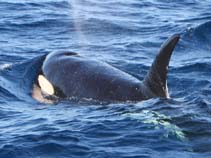Orcinus orca (Linnaeus, 1758)
Killer whale| Native range | All suitable habitat | Point map | Year 2050 |

|
| This map was computer-generated and has not yet been reviewed. |
| Orcinus orca AquaMaps Data sources: GBIF OBIS |
Classification / Names Κοινά ονόματα | Συνώνυμα | CoL | ITIS | WoRMS
Mammalia | Cetartiodactyla | Delphinidae
Environment: milieu / climate zone / εύρος βάθους / distribution range Οικολογία
Πελαγικό(ά); ωκεανόδρομο(ς) (Αναφ. 75906); εύρος βάθους 0 - 2652 m (Αναφ. 116169). Tropical; 90°N - 90°S, 180°W - 180°E
Distribution Χώρες | Περιοχές FAO | Οικοσυστήματα | Παρουσίες | Εισαγωγές
Circumglobal. Climate: cosmopolitan.
Length at first maturity / Μέγεθος / Weight / Age
Γεννητική Ωρίμανση: Lm ?, range 570 - 660 cm Max length : 980 cm TL αρσενικό/απροσδιόριστο; (Αναφ. 1394); 850 cm TL (female); μεγ. δημοσιευμένο βάρος: 10.0 t (Αναφ. 1394)
Life cycle and mating behavior Γεννητική Ωρίμανση | Αναπαραγωγή | Γεννοβολία | Eggs | Γονιμότητα | Larvae
Main reference
Αναφορές | Συντονιστής | Συνεργάτες
Tan, J.M.L. 1995 A Field Guide to the Whales and Dolphins in the Philippines. Makati City: Bookmark. 125 p. (Αναφ. 936)
IUCN Red List Status
(Αναφ. 130435: Version 2025-1)
CITES status (Αναφ. 108899)
CMS (Αναφ. 116361)
Threat to humans
Human uses
αλιεία: Εμπορικό(ά)
FAO - αλιεία: landings, species profile | FishSource | Η θάλασσα γύρω μας
Εργαλεία
Περισσότερες πληροφορίες
Διαδικτυακές πηγές
BHL | BOLD Systems | CISTI | DiscoverLife | FAO(αλιεία: species profile; publication : search) | Fishipedia | GenBank (genome, nucleotide) | GloBI | Gomexsi | Google Books | Google Scholar | Google | PubMed | Δέντρο Ζωής | Wikipedia (Go, αναζήτηση) | Zoological Record



